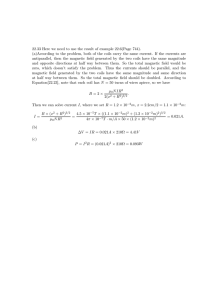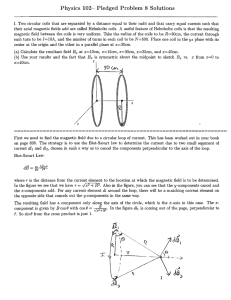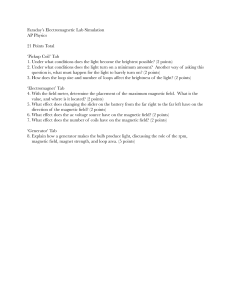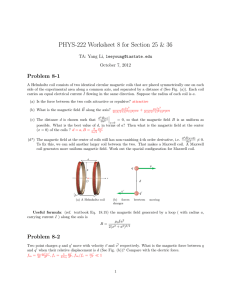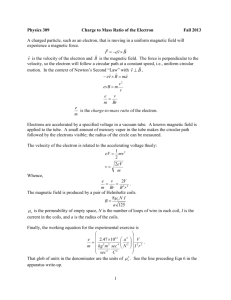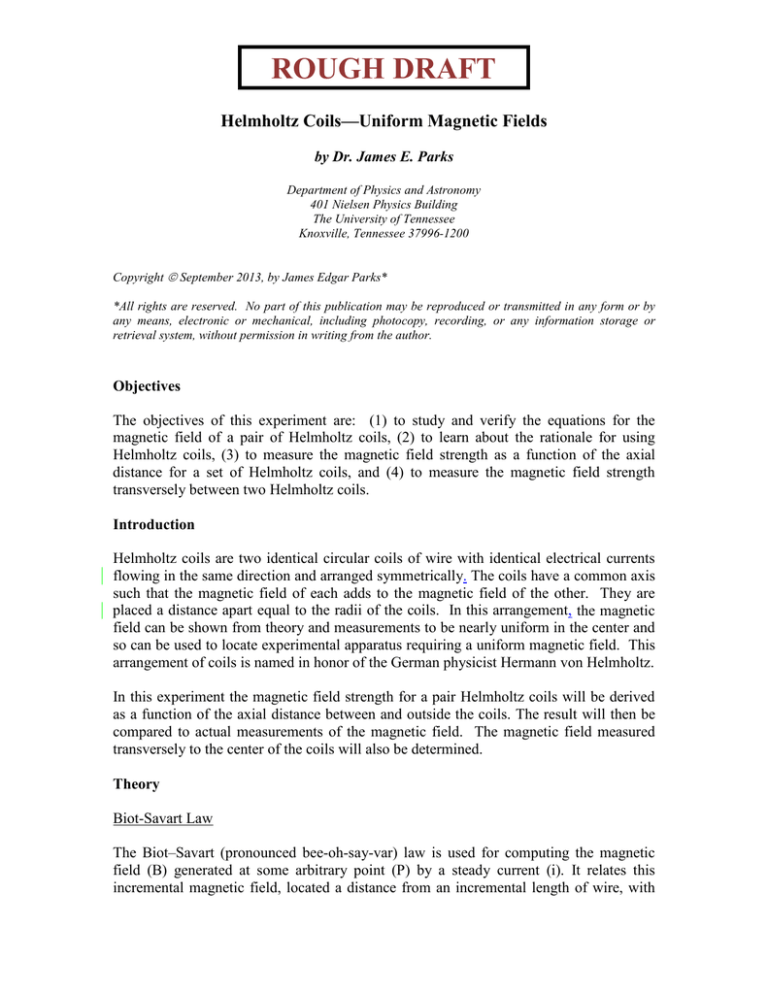
ROUGH DRAFT
Helmholtz Coils—Uniform Magnetic Fields
by Dr. James E. Parks
Department of Physics and Astronomy
401 Nielsen Physics Building
The University of Tennessee
Knoxville, Tennessee 37996-1200
Copyright September 2013, by James Edgar Parks*
*All rights are reserved. No part of this publication may be reproduced or transmitted in any form or by
any means, electronic or mechanical, including photocopy, recording, or any information storage or
retrieval system, without permission in writing from the author.
Objectives
The objectives of this experiment are: (1) to study and verify the equations for the
magnetic field of a pair of Helmholtz coils, (2) to learn about the rationale for using
Helmholtz coils, (3) to measure the magnetic field strength as a function of the axial
distance for a set of Helmholtz coils, and (4) to measure the magnetic field strength
transversely between two Helmholtz coils.
Introduction
Helmholtz coils are two identical circular coils of wire with identical electrical currents
flowing in the same direction and arranged symmetrically. The coils have a common axis
such that the magnetic field of each adds to the magnetic field of the other. They are
placed a distance apart equal to the radii of the coils. In this arrangement, the magnetic
field can be shown from theory and measurements to be nearly uniform in the center and
so can be used to locate experimental apparatus requiring a uniform magnetic field. This
arrangement of coils is named in honor of the German physicist Hermann von Helmholtz.
In this experiment the magnetic field strength for a pair Helmholtz coils will be derived
as a function of the axial distance between and outside the coils. The result will then be
compared to actual measurements of the magnetic field. The magnetic field measured
transversely to the center of the coils will also be determined.
Theory
Biot-Savart Law
The Biot–Savart (pronounced bee-oh-say-var) law is used for computing the magnetic
field (B) generated at some arbitrary point (P) by a steady current (i). It relates this
incremental magnetic field, located a distance from an incremental length of wire, with
Helmholtz Coils
the current flowing in the direction of the incremental length. It relates both the
magnitude and direction of the magnetic field to the magnitude of the current, the
magnitude and direction of the incremental length, and the distance from the increment of
length to the point of interest.
The magnetic field is calculated by summing up all the increments of B resulting from
incremental lengths of current that produce the magnetic induction.
The law is named for Jean-Baptiste Biot and Felix Savart, who first formulated this
relationship in 1820. Using the principle of symmetry, the Biot-Savart law will be used
in this experiment to determine the magnetic field strength as a function of distance along
the axis of a single circular coil of wire carrying current i. The result will be used to
determine the magnetic field of a pair of Helmholtz coils along their axis of symmetry.
Figure 1. The incremental magnetic field strength, ∆B , at point
P is given by the
µ i ∆l × r
µ i ∆l sin θ
Biot-Savart law, ∆B = 0
or in vector form, ∆B = 0
.
2
r
4π
4π r 3
The Biot-Savart law can be better understood and applied by considering Figure 1, which
depicts a randomly-shaped wire with a steady current i flowing in it. According to the
Biot-Savart law, the magnetic field ∆B resulting from the current flowing in a small
length of the wire ∆l at some arbitrary distance r away is given by the equation
µ i ∆l sin θ
∆B = 0
r2
4π
(1)
where θ is the angle between the incremental vector length ∆l and the vector distance r
to point P. Magnetic field is a vector quantity having both a magnitude and direction.
Likewise, the incremental length ∆l and the distance r from the current segment to the
point P are also vector quantities. In vector form, Equation (1) can be rewritten as
µ0i ∆l × r
∆B =
4π r 3
10/14/2013
2
(2)
Helmholtz Coils
where the term ∆l × r is known as the cross product and has a magnitude equal
to ∆l r sin θ , or
∆l × r =∆l r sin θ .
(3)
The cross product, ∆l × r , has a direction that is perpendicular to both ∆l and r and is
the direction that a right-hand screw would advance if ∆l is rotated onto r through the
smallest angle.
a. Side View
b. Three dimensional view from top
Figure 2. Schematic diagrams for determining the axial magnetic field along the x axis at
point P for a single circular loop of current i.
Figure 2 shows two views of a single circular loop of current with point P lying on the
symmetrical axis a distance x from the plane of the circular loop. The magnetic field
along the axis of a single circular loop of wire carrying a current i can be determined with
the Biot-Savart law by dividing the loop into a large number of incremental lengths, each
being perpendicular to the vector distance to the point of interest. The increments can
then be summed to find the resultant magnetic field. The Biot-Savart law from Equation
(2) yields the vector form of the magnetic field increment
µ0i ∆l × r
∆B =
4π r 3
(4)
while Equation (1) provides the magnitude of the vector
µ i ∆l sin θ
.
∆B = 0
r2
4π
(5)
The vector ∆B can be resolved into parallel and perpendicular components with respect
10/14/2013
3
Helmholtz Coils
to the central axis along x using the unit vectors iˆ and ĵ so that
∆B = ∆Biˆ + ∆B⊥ ˆj ,
(6)
where ∆B is a component along the x-axis and ∆B⊥ is a component perpendicular to the
x-axis. ∆B and ∆B⊥ are related to the magnitude of ∆B , ∆B , by the following
equations
and
∆B =
∆B cos α
(7)
∆B⊥ =
∆B sin α ,
(8)
where α is the angle between the plane of the loop and the vector from the line segment
∆l to point P.
The total magnetic field is then found by summing all the increments of ∆B for every
increment of ∆l so that
B = Σ∆B = Σ∆Biˆ + Σ∆B⊥ ˆj .
(9)
Since the components ∆B⊥ are all equal and point in all directions, their sum will be zero
so that
B⊥ = Σ∆B⊥ = 0 .
(10)
B = Σ∆Biˆ .
(11)
This leaves
Substituting Equation (7) into Equation (11) and Equation (5) into the result yields
B = Σ∆B = Σ
=
r
Since θ = 90 and
µ0i ∆l sin θ
µ i sin θ
cos α = 0
cos α Σ∆l .
2
r
4π
4π r 2
(12)
R 2 + x 2 , then
sin θ = 1
(13)
and
R
cos α =
10/14/2013
R + x2
2
4
.
(14)
Helmholtz Coils
By making these substitutions, Equation (12) becomes
B
=
µ0i 1
µ0i
R
R
=
Σ∆l
Σ∆l .
2
2
2
2
2
4π R + x R + x
4π ( R + x 2 ) 3 2
(15)
Since all the ∆l ’s can be made arbitrarily as small as they need to be, their sum will
equal the circumference of the circular coil and
Σ∆l = 2π R .
(16)
Inserting Equation (16) into Equation (15) produces the final result
B
=
µ0i
µ0i
R
R2
R
=
2
π
4π ( R 2 + x 2 ) 3 2
2 (R2 + x2 ) 32
(17)
and
B=
µ0i
R2
.
2 (R2 + x2 ) 32
(18)
Equation (18) provides the magnitude of the magnetic field of a single circular turn of
wire of radius R carrying a current i as a function of distance x from the center of the coil
to a point P on the central axis of symmetry. The constant µ0 is called the permeability
of free space and is equal to 1.26x10-6 Tesla·meter/Ampere (T·m/A). For a coil of N
turns of wire carrying a current i, Equation (18) becomes
B=
µ0 Ni
2
R2
(R2 + x2 )
3
.
(19)
2
This equation can now be used to determine the magnetic field of a pair of Helmholz
coils as shown in Figure 3. The two coils are separated from each other by a distance
equal to their radii, R. The magnetic field along their axis of symmetry at a point P a
distance x from their center can be determined for each coil and the fields can be added
together for the final result. If the currents in each coil are in the same direction, then the
fields will complement each other to produce a strengthened magnetic field at each point.
If the currents flow in opposite directions, the fields will counteract to produce a lesser
field strength.
10/14/2013
5
Helmholtz Coils
Figure 3. A pair of Helmholtz coils, each of radius R and separated by a distance R.
Each coil has N turns of wire with a current i flowing in each in the same direction. The
magnetic fields of each are additive and their sum is determined at point P, a distance x
from the center of the arrangement. The distance x is related to the distances x1 and x2
R
R
from coil #’s 1 and 2, respectively, by x1= x + and x2= x − .
2
2
Using a new, unique notation for the magnetic fields of coil #1 and coil #2 and applying
them in Equation (19), the magnetic fields at Point P will be
B1 =
µ0 Ni
R2
( R 2 + x12 )
2
(20)
3
2
and
B2 =
µ0 Ni
2
R2
(R + x )
2
2
2
3
(21)
2
for coils #1 and #2, respectively. The total magnetic field at point P will then be the sum
of the fields, B1 and B2 , so that
B = B1 + B2 =
µ0 Ni
2
R2
( R 2 + x12 )
3
+
2
µ0 Ni
2
R2
( R 2 + x22 )
3
.
(22)
2
In order to determine the magnetic field at point P as a function of the distance x
measured from the center point between the two coils, a coordinate transformation needs
to be made. This transformation can be understood by referring to the diagram in Figure
3. It is evident that the distance x is related to the distances x1 and x2 from coil #’s 1
and 2, respectively, by the equations
x1= x +
10/14/2013
6
R
2
(23)
Helmholtz Coils
x2= x −
R
.
2
(24)
Substituting these equations into Equation (22) yields the final result
=
B
1
1
+
R2
.
R 2 32
R 2 32
2
2
2
[R + ( x + ) ]
[R + (x − ) ]
2
2
µ0 Ni
(25)
If the current in either coil is in the opposite direction from the other, either B1 or B2 , as
appropriate, will need to be assigned a negative value to indicate that its direction is
opposite to the other and will need to be subtracted from the value.
Theoretical Computation
In order to have some idea of what to expect in the measurements of the axial magnetic
fields of a pair of Helmholtz coils and to verify the theoretical expression in
Equation (25), use Excel to make a calculation of the magnetic field as a function of the
axial distance from the center of the two coils.
1. Open an Excel spreadsheet and enter text into cells A1 through A4 as follows:
A1: µ₀, permeability of free space
A2: N, number of turns of wire on each coil
A3: i, the current flowing in each coil
A4: R, the radius of each of the coils
2. In cells B1 through B4, enter the values of these constants. For the present, use 1.0 for
the current value, but change it later when the current is determined.
3. Label the cells A10, B10, and C10 by entering the text x, B, and B. In the cells B9 and
C9 enter the text Additive and Opposing.
4. In cells A11 through A91 enter the numbers -.4 to .4 in 0.01 increments. This
represents values in meters from -40 to +40 centimeters as measured from the center
of the coils.
5. In column B, using Equation (25), calculate the magnetic field along the axis of
symmetry from -0.4 meters to +0.4 meters in 1 centimeter (0.01 meters) increments.
It may be useful that Equation (25) can be written in Excel as the following if the
above procedure is adhered to:
=($B$1*$B$2*$B$3*($B$4^2)/2)*((1/(($B$4^2+(A11+($B$4/2))^2)^1.5))+(1/(($B$4^2+(A11-($B$4/2))^2)^1.5)))
Note: Equation (25) has multiple mathematical operations and attention needs to be
given to the order of the operations in order to obtain the correct result. Excel follows a
specific order in performing mathematical calculations. The order of operations can be
changed by adding parentheses to the calculation. Terms inside parentheses that are
10/14/2013
7
Helmholtz Coils
inside other parentheses are processed first, and the calculations continue to the next
inside parenthetical term.
Exponential terms are calculated with the next highest
priority, followed by division and multiplication operations, and these in turn are
performed before addition and subtraction. Any operation(s) contained in brackets will
be carried out first, followed by any exponents. After that, Excel considers division or
multiplication operations to be of equal importance and carries out these operations in the
order they occur from left to right in the equation. The same goes for the next two
operations: addition and subtraction. They are considered equal in the order of operations.
The operation that appears first in an equation, either addition or subtraction, is the one
carried out first.
The order of operations in Excel may be remembered with the acronym: BEDMAS. The
order of operations is then:
Brackets (parentheses ( ) only may be used in Excel and not [ ] or { }.)
Exponents
Division
Multiplication
Addition
Subtraction
6. Create a graph of the magnetic field versus the distance from the center of the two
coils.
7. Make a second column and perform the same calculation, but with the currents
flowing in opposite directions.
8. Add the results of this calculation to your graph.
Apparatus
The Helmholtz magnetic field apparatus is shown in Figure 4. It is composed of 2 Pasco
Model EM-6723 500-turn wire coils whose diameters are about 21 cm. They are affixed
to a custom-made rotatable rail carrier. The two coils are separated from each other
about 10.5 cm. Each coil has a resistance of about 17.5 ohms and they can be connected
in series or in parallel with their respective currents flowing in the same or in the opposite
direction. They are rated for the current not to exceed 2 amperes. They are powered with
a Pasco Model PI-9877 0-18 VDC power supply capable of supplying 1 ampere of
current.
The magnetic field is measured with a Pasco Model CI-6520A magnetic field sensor
connected to a Pasco ScienceWorkshop 750 Interface, which in turn is connected to a
computer via a USB port. Pasco Capstone software is used for data acquisition and
measurement. The sensor is mounted on a custom bar that is mounted to Newport Model
PRC-3 rail carrier. This rail carrier and the rotatable carrier are mounted to a Newport
Model PRL-36 precision optical rail of length 92 cm for accurately measuring distance.
This apparatus can be used to accurately measure B as a function of a precisely
determined distance x along the axis of symmetry of the coils. The coils may be rotated
10/14/2013
8
Helmholtz Coils
90º so that the magnetic field can be measured transversely across the midway point
between them.
Figure 4. Apparatus and setup for Helmholtz Coils magnetic fields experiment.
Procedure
Pasco Capstone Data Acquisition Setup
1. Turn on the Science Workshop 750 Interface and open the Pasco Capstone program.
icon at the left side of the screen. Select Add
2. Click on the Hardware Setup
Sensor/Instrument and then select Magnetic Field Sensor from the menu of analog
sensors. Close the Hardware Setup window by clicking on the icon again.
3. Create two new pages using the New Page
icon right above the Tools Palette and
next to the Page #1 tab. Name the pages Axial #1, Axial #2, and Transverse by
choosing the appropriate page tab and double clicking on it or by clicking on the
Workbook option on the main menu and choosing the rename option from the
submenu.
4. Place a table and a graph in each page by clicking on the Table & Graph
icon
in the QuickStart menu of templates.
5. Put each page in Keep Mode by clicking the down arrow next to the Continuous
Mode
icon at the bottom-left and selecting Keep Mode
.
6. For the first column in each of the tables and the x axis of each of the graphs, click on
<Select Measurement> to activate a menu of choices. Choose the Create New option
and User-Entered Data option from the submenu. Type “Position on Rail,” followed
by the Enter key, and then “centimeters,” followed by the Enter key.
7. For the <Select Measurement> option for the second column, use Magnetic Field
Strength (10X).
8. Click on the <Select Measurement> sections of the graph and choose Position on Rail
and Magnetic Field Strength (10X) for the horizontal and vertical axes, respectively.
9. Click on the magnetic field column of the table and then the Properties icon
in
the table’s upper toolbar and change the Number Style (under the heading Numerical
10/14/2013
9
Helmholtz Coils
Format) to scientific notation. Note: You may have to resize this submenu window
to fully see the options.
10. Fill in the first column of each table with the numbers 16 to 88. Note: You may do
this by hand or use your Excel expertise to make a column of numbers using the copy
down feature and then copying and pasting the numbers into the first column of the
Capstone table.
11. Change the sample rate of the Magnetic Field Sensor to 1.00 Hz by clicking on the
down arrow of the sample rate icon,
in the lower-left Controls
bar.
12. With the Capstone program now set up, you are ready to begin taking data.
Apparatus Setup Procedure
1. The two Helmholtz coils should be wired in series with the power supply such that
the currents in each coil are flowing in the same direction, e.g., either clockwise or
counterclockwise (see Figure 5). The directions of the windings are indicated on each
coil as shown in Figure 6.
Figure 5. Schematic of wiring coils in series.
2. Recall the right hand rule for indicating the direction of a magnetic field for a coil of
wire carrying a positive current: If you curl the fingers of your right hand in the
direction that positive current flows in the coil, your thumb will point in the direction
of the magnetic field.
3. The magnetic sensor is capable of measuring fields either axially or transversely to
the sensor. The choice is made with a slide switch labeled RADIAL/AXIAL and direction
arrows as shown in Figure 5. For your first measurement, choose the axial position.
The double arrows indicate the direction of a magnetic field that the sensor will give a
positive value.
4. The magnetic sensor has 3 gain settings: 1X, 10X, and 100X. Position the slide switch
for the 10X gain setting.
10/14/2013
10
Helmholtz Coils
Figure 6. Label showing direction of windings of coils for determining direction of the
flow of current and image of magnetic sensor selection switches.
5. With the power supply off, click the Preview
icon in the lower-left Controls bar
of the Axial #1 page. Remember that the Keep Mode has been selected in the
Capstone setup procedure. The magnetic field value will then appear in the first cell.
Make sure the value shown is in scientific notation. The push button on the magnetic
sensor is a Tare button (see Figure 6). With no current flowing in the coils, pushing
this button will null any extraneous magnetic fields that would affect the
measurements. Tare or zero the sensor by pushing this button and you should
observe the preview reading to be a small number.
6. Place the end of the sensor near the center of the two coils and turn on the power
supply. Adjust the voltage to the maximum value of 18 volts. Observe the preview
reading; it should now be several factors of 10 larger and be reading the correct value
of the magnetic field.
7. Toggle the display button on the power supply to change the digital reading from
volts to amperes and record the value in your spreadsheet for the calculation based on
Equation (25).
Data Acquisition Procedure
1. If you have carefully followed the above procedures, the measurement system should
be ready to acquire data in a quick and systematic way. Begin by positioning the rail
carrier with the sensor at the 16 cm mark.
2. Since you have already entered the Position on Rail values into the table, these will be
the positions where you will take readings. In the Preview mode, if you click on the
Keep Sample
button when you are ready to begin taking a series of
measurements, the magnetic field value at that position will be recorded in the
appropriate cell for that position. The preview reading will then move to the next cell
and activate it to receive the next reading when the Keep Sample button is clicked.
This eliminates having to activate each cell manually with the mouse when changing
positions.
3. Reposition the rail carrier to the next position and click on the Keep Sample button
repeatedly at each centimeter marking until the last value, the 88 cm position, is
reached.
4. When you are finished collecting readings, hit the Stop button.
5. To make the graph fit itself to your measurements, click on the Scale to Fit
at the far left on the graph’s toolbar.
10/14/2013
11
icon
Helmholtz Coils
6. It may be useful to change the names of the runs.
7. Remember to save early and often.
Analysis and Results
1. Since the theoretical expression for the magnetic field given by Equation (25) is in
terms of distance x measured from the center of the coils, make a coordinate
transformation to change the Position on Rail values to distance. To do this, find the
position of the rail carrier that locates the end of the magnetic sensor at the axial
center between the two coils. Record this position for use in the next step.
2. Click on the Position on Rail column of the table and then click on the Insert
3.
4.
5.
6.
7.
8.
9.
on the table toolbar. It is the third one from the left.
Calculated Column icon
The column will be labeled Calc1 and the calculation will be set up as follows,
allowing you to type in the calculation based on the values in the Position column:
Calc1=[Position on Rail(centimeters]
Subtract the position value at which the white dot on the magnetic sensor is centered
between the two coils and enclose these terms in parentheses; then multiply the result
by 0.01 to convert the distance from centimeters to meters. For example, if the probe
is centered when the rail carrier is at 48, then the result would look like:
Calc1=([Position on Rail(centimeters)]-48)*.01
Highlight and copy the distances and measured values for the magnetic field and
paste these into two columns of your Excel spreadsheet, for example, columns E and
F, starting at cells E8 and F8.
Add these to the graph of your calculated values and compare them.
Go to Page #2 and repeat your measurements for the two coils with the currents
flowing in opposite directions. Add this data to your graph.
Go to Page #3 and rotate the coils 90º. Change the slide switch on the sensor to the
radial position and repeat the measurements for the transverse distance across the
coils from outside the coils, in between the coils, and outside the coils on the opposite
side.
Copy and paste your results in your spreadsheet. Compare these with your other
measurements.
10/14/2013
12

